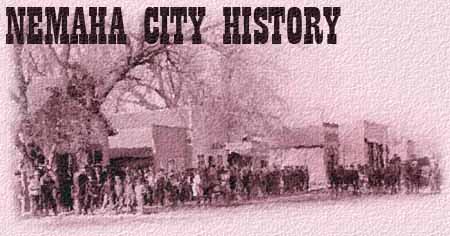|
From Wm. Cutler. "Nemaha County," History of Nebraska, 1882. This
article contains hundreds of surnames of early pioneers and settlers in
Brownville. There is much here to learn about the early history of one
of Nebraska's first communities. For further information, go to the
History of Nebraska site directly (link below).
•
Cutler/Andreas 1882 History of Nebraska,
Nemaha County
|
|
The Nemaha town site was selected in 1854. Allen L.
COAT was the surveyor and the first person to erect his cabin. The
1855-56 legislature granted a charter for a ferry boat crossing the
Nemaha River and a mill dam. This was the crossing point for the trail
leading to Falls City, Rulo, St. Joseph, and other points south.
Later, Mr. ELLIOTT built a bridge which the county purchased in 1867.
A bridge was also built at BENNETT's saw mill west of town. A grist
mill was also added. The first post office was established July 1,
1856, with Jerome HOOVER as postmaster.
On July 1, 1857, Nemaha City covered 300 acres, on a
beautiful plateau covered with waving grass and wild flowers. Its
buildings consisted of two or three log cabins, and a few cottonwood
shanties. In one of those temporary buildings, Dr. Jerome HOOVER had
installed a grocery store, where the doctor made his headquarters, and
his son, Birl, carried on the thriving grocery business which was
patronized by the immigrants who were constantly passing, some to
Kansas, and others to points in Nebraska, for a suitable location to
settle.
In 1857, all of the land south of the Nemaha River was
vacant except for a few places on the Otoe Reservation, which was
occupied by half-breeds and Indians. The land bounding Nemaha on the
north was school land.
On July 4, 1857, a celebration in the public square was
promoted by a few pioneers. An ox had been barbecued. Long tables and
benches were improvised out of cottonwood lumber borrowed from the
Silas TIDWELL sawmill, which was the first sawmill in Nemaha County.
The river bottom at that time contained many acres of cottonwood
timber which was sawed into lumber for building purposes.
The winters of 1857 and 58 were fine open winters.
Carpenters could be seen working in their shirt sleeves. Everybody was
pressed into the building service who could wield a hammer. Another
sawmill west of town, on the Nemaha River, had been put into
operation, which converted walnut logs into lumber.
New houses and businesses appeared like magic, and
immigrants poured in at a rapid rate, by every kind of conveyance
imaginable. The Missouri river was navigable. The packets, which were
comfortable, averaged three per day. They were laden with produce and
merchandise as well as passengers.
Within one year there were two commodious hotels, and
numerous shops and stores were built on short notice. A Mr. BARNES
made fine brick and pottery ware along the bluff northeast of town.
Several brick buildings were erected out of this brick.
The first schoolhouse was built about the year 1859. It
was a small cottonwood building. It served also for church, Sunday
school and all public meetings. At this time there was a select school
started and conducted by J.C. CRANDALL and his wife where older
children attended.
The Episcopal denomination built the first church. It
was a very pretty Gothic structure made of walnut lumber secured from
the David LOCKWOOD woodlot on the Nemaha River bottom, and sawed by
the BENNETT sawmill nearby.
Ô
|

